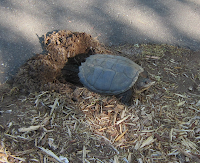-by Wildlife Educator, Ben Betterly
So what did come first, the chicken or the egg? This age-old
causality dilemma has perplexed humans since the dawn of civilization. To
ancient philosophers, the question about the first chicken or egg evoked the
questions of how life, and the universe in general, began. Charles Darwin’s theory of biological evolution
via natural selection set the story straight, or at least changed the question.
We now know that the egg predated the chicken, as chickens (and all other
birds) share a common ancestor with reptiles, which also lay eggs.
Spring is the time that egg-layers lay their eggs; and
different species have different strategies.
Many birds, of course, build nests in which to lay their eggs. Other
animals build nests too, but birds do so in an extraordinary variety of forms,
materials, and sites. In the Northwoods,
the Bald Eagle takes the prize for the largest nest, which can measure up to 6
ft. in diameter and weigh upwards of 2 tons (4000 lbs)! The smallest nest (and eggs) goes to the
Ruby-Throated Hummingbird, which produce structures merely 2 in. in diameter.
 |
| Song Sparrow Nest and Egg (C) Ben Betterly |
Many birds build nests in the branches of trees, but not all
do. Song Sparrows will often build their nests directly on the ground. Natural selection has provided their eggs
with camouflage (light brown, with a spackling of dark brown) to avoid being
seen and eaten by potential predators. Only birds lay eggs with pigmented colored
shells; and some birds such as American Robin (and others in the Thrush family)
lay bright blue eggs! Scientists are still not sure of the function of the blue
coloration, and it’s hard to imagine how natural selection would allow such a
brightly colored egg to persist. For one thing, Robins make their nests high
among tree branches where their eggs will be kept relatively safe from hungry
predators.
Most birds put a great amount of effort in brooding their
hatch. They must first select a proper site, build a nest, lay their eggs,
incubate, and once hatched, take vigorous care of their chicks. Few reptiles can compare to the parenting
determination of birds (although evidence suggests that some Dinosaurs had
highly developed parenting behaviors). Most
Reptiles such as many turtles, simply find a suitable a spot to drop off their
eggs, and hope for the best.
 |
| A snapping turtle lays her eggs right in the Center's parking lot! (c)Licia Johnson |
If you want to read a bit more on the subject of eggs - here's a cool article on science daily news about the intensity of color in robins eggs correlating to the degree of parental care.
No comments:
Post a Comment